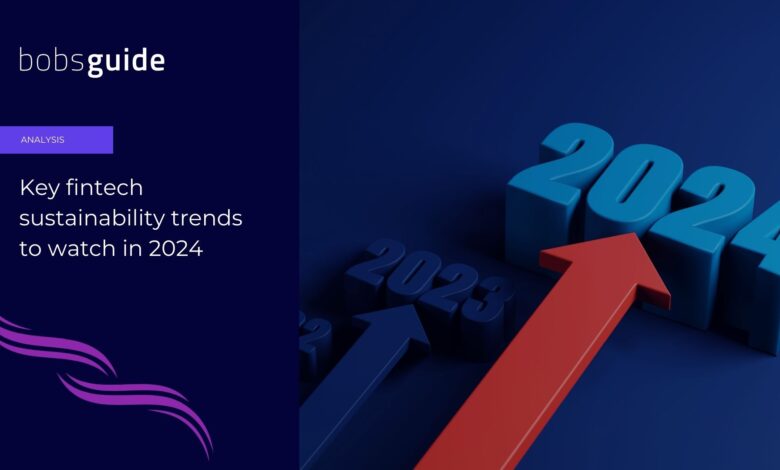Key fintech sustainability trends to watch in 2024

The future of fintech sustainability hinges on the mainstream adoption of innovative technologies, including carbon-offsetting mobile solutions, green loans, and the rise of digital payments, paving the way for environmentally friendly cryptocurrencies and reducing the environmental impact across the financial sector.
The significance of fintech sustainability in 2024 cannot be overstated, evolving not merely as a trend but as a fundamental shift within the financial services sector. This shift underscores sustainability as a core operational mandate, propelled by the integration of artificial intelligence, blockchain, and digital payments into everyday financial transactions.
The landscape of fintech is being reshaped by digital wallets, contactless payments, and green fintech technologies, making the pursuit of eco-friendly solutions a license to operate in the modern financial world.
As we navigate through 2024, these are the key fintech sustainability trends signalling a promising outlook for green fintech:
-
Open banking and sustainability
Open banking is revolutionising the financial landscape by mandating that banks share data with third parties, thus promoting competition, transparency, and customer control over finances. This legislative push is integral to fostering a sustainable future within the fintech sector. Here are the key ways open banking is influencing sustainability:
- Enhanced financial ecosystem efficiency: By making certain banking data public, open banking fosters a more connected financial ecosystem. This connectivity allows for sustainability to be a primary consideration in financial operations.
- Innovation in payment solutions: Expected to significantly impact the payments space in 2024, innovations like Pay by Bank and Variable Recurring Payments (VRP) facilitate instant and secure transactions. These methods not only offer convenience but also reduce the need for physical banking resources, aligning with sustainability goals.
- Support for small and medium-sized enterprises (SMEs): Open banking enables a comprehensive view of an SME’s financial health, leading to faster and more personalised financing solutions. This support is crucial for SMEs that prioritise sustainable practices but may lack the resources for big-scale transformations.
- Regulatory and digital advancements: As regulatory pressure mounts, especially in Europe, to manage sustainability-related risks, open banking is at the forefront, enabling new digital services that help reduce carbon footprints. Tools like Greenly and Svalna leverage open banking to provide users insights into their environmental impact, promoting conscious financial decisions.
- The Perseus Project: This initiative is particularly notable as it seeks to create a trustworthy framework correlating energy generation with usage data without the need for blockchain or cloud monopolies. This project exemplifies how open banking can facilitate significant green investments by ensuring transparency and trust in sustainability reporting.
-
Environmentally-friendly cryptocurrencies
The growing concern over the environmental impact of traditional cryptocurrencies like Bitcoin, which uses a highly energy-intensive Proof of Work (PoW) consensus mechanism, has spurred the development of more sustainable alternatives. These eco-friendly cryptocurrencies are pivotal in reducing the carbon footprint associated with digital financial transactions. Here are key points highlighting the shift towards greener cryptocurrencies:
- Proof of Stake (PoS) consensus mechanism: Unlike PoW, PoS requires significantly less computational power, thereby reducing energy consumption. Cryptocurrencies like Ethereum and Tezos have adopted PoS, leading to lower energy use and enhanced transaction speeds.
- Green cryptocurrencies and innovations:
- Green bitcoin: Utilizes PoS, making it an eco-friendlier option.
- eTukTuk (TUK): Supports electric vehicle charging stations, promoting cleaner energy use.
- Bitcoin Minetrix (BTCMTX): Focuses on decentralising cloud mining, reducing energy demands.
- Energy efficiency metrics:
- Cardano (ADA): Known for being vastly more energy-efficient than traditional mining processes.
- Solana (SOL): Offers high transaction speeds with minimal energy consumption, supporting up to 65,000 transactions per second.
- Nano (XNO): Operates without transaction fees and maintains low energy usage.
By integrating energy-efficient technologies and committing to sustainable practices, these cryptocurrencies are setting a new standard for the industry.
-
Digital wallets and reduced environmental impact
Digital wallets are revolutionising financial transactions by minimising the environmental footprint traditionally associated with banking.
One major benefit is the reduction in paper and plastic use. Digital wallets significantly reduce the need for physical banknotes, cheques, and plastic cards, addressing issues like deforestation and plastic pollution. This shift not only conserves natural resources but also cuts down on waste, making financial activities more sustainable.
Moreover, digital wallets contribute to energy efficiency. By eliminating the need for physical banking infrastructure and reducing reliance on ATMs, digital wallets can decrease overall energy consumption. This makes digital transactions not only more convenient but also more energy-efficient compared to traditional banking methods.
Digital wallets also promote eco-friendly practices by facilitating paperless billing and receipts, thus promoting a paperless environment. Moreover, they allow users to track spending more effectively, which can lead to more responsible consumption patterns.
The adoption of digital wallets has been instrumental in enabling remote work and online shopping, which in turn reduces transportation emissions associated with commuting and in-store shopping. This indirect benefit helps in reducing the overall carbon footprint of daily activities. Finally, digital wallets also promote financial inclusion by providing accessible financial services to those who may be excluded from traditional banking systems.
-
Contactless payments for eco-friendly transportation
Contactless payments in public transportation systems epitomise efficiency and sustainability, enhancing the commuter experience while significantly reducing environmental impact.
First of all, contactless payments accelerate the transaction process, eliminating the need for cash or physical tickets, which streamlines commuting significantly. This efficiency not only reduces operational costs but also minimises the time spent by commuters at ticket counters or machines.
Moreover, open architecture ticket validators are capable of reading various types of contactless payments, from cards to mobile wallets, ensuring compatibility and convenience. This technology helps in reducing long queues and wait times, thereby enhancing commuter satisfaction and reducing crowd-related energy consumption.
Another technology supporting sustainability is MaaS platforms that utilise ABT systems to offer seamless planning, booking, and payment for multimodal travel. This integration provides a comprehensive service that supports sustainable transportation by encouraging public transport usage over private vehicle travel, thus reducing overall vehicle emissions.
By eliminating the need for paper and plastic in ticketing, contactless payment systems also contribute significantly to environmental conservation. Additionally, features like fare capping encourage more frequent use of public transport, which plays a vital role in reducing the carbon footprint associated with personal vehicle use.
-
Mobile solutions for carbon offsetting
Mobile solutions are playing an increasingly significant role in carbon offsetting within the realm of fintech. These innovations offer a range of tools and features aimed at empowering individuals and businesses to mitigate their environmental impact effectively.
One key aspect of this trend is the emergence of app-based carbon footprint calculations. Mobile applications provide users with insights into their personal carbon footprints, often accompanied by options to offset emissions by investing in verified projects such as reforestation or renewable energy initiatives. Certain apps take personalisation to the next level by offering tailored carbon offsetting plans based on individual or corporate carbon footprints. Users can choose from a variety of projects, ranging from solar energy initiatives to forest conservation efforts, aligning with their specific impact and preferences.
Fintech platforms are also integrating crowdfunding features for green initiatives. This allows users to participate in collective efforts to fund environmental projects, fostering both carbon offsetting and community involvement in sustainability efforts.
Cost-effectiveness is also a significant factor in mobile carbon offsetting. With various apps offering competitive pricing for carbon offsets, users can find solutions that match their financial capabilities, thereby making sustainability accessible to a broader audience. Moreover, innovative technologies such as AI and blockchain are being leveraged to enhance the accuracy of carbon tracking and the efficiency of offset projects.
-
Green investments
Fintech is rapidly emerging as a key driver in directing investments towards environmentally sustainable projects, transforming the landscape of green finance. Through various avenues, fintech facilitates green investments in innovative and impactful ways.
One significant aspect is the rise of innovative funding platforms pioneered by fintech companies like Raise Green and MioTech. These platforms enable investors to directly support renewable energy projects and green startups, aligning their investment portfolios with their environmental values.
Another crucial contribution comes from sustainable robo-advisors, which leverage AI and advanced analytics to recommend sustainable investment options based on environmental, social, and governance (ESG) criteria. By analysing vast datasets, these robo-advisors empower investors to make informed decisions that prioritise sustainability.
Fintech also utilises blockchain technology to ensure transparency and security in green investments. Through blockchain, the traceability of the green supply chain is enhanced, from production to consumption, bolstering investor confidence in the process. Fintech firms also leverage big data to provide detailed analytics on ESG factors, aiding investors in assessing the environmental impact of their investment portfolios.
The emergence of green bonds and sustainable investment funds, facilitated by fintech platforms since the late 2000s, offers another avenue for supporting environmentally beneficial projects such as clean energy and sustainable agriculture. Additionally, fintech developments in Regulatory Technology (RegTech) play a crucial role in ensuring compliance with environmental regulations.
Conclusion
Taking stock of the abovementioned developments, the future of fintech appears not only bright but green. These initiatives, deeply intertwined with the operational mandates of financial institutions, highlight a significant shift towards embedding sustainability in the core framework of financial services.
Looking ahead, the progression toward greener fintech solutions underscores the potential for transformative impact on both the industry and the planet. The key trends discussed, from open banking facilitating green investments to mobile solutions for carbon offsetting, set the stage for a robustly sustainable fintech ecosystem. This evolution not only caters to the rising consumer demand for green and ethical financial services but also stands as a testament to the innovative potential of the fintech sector to contribute meaningfully to the global sustainability agenda.



